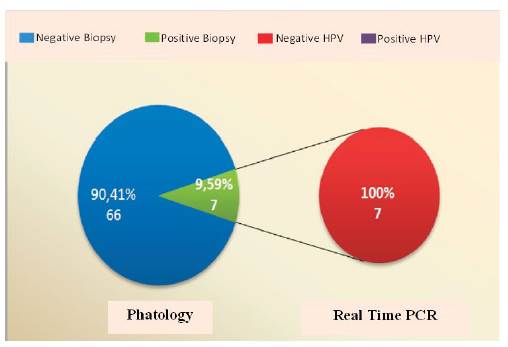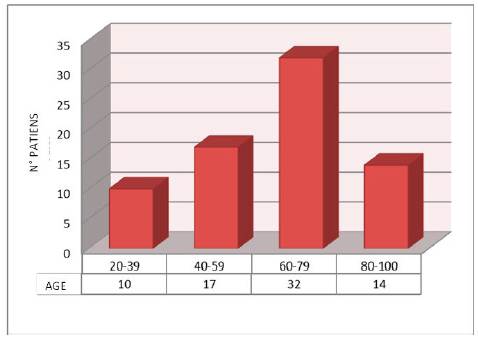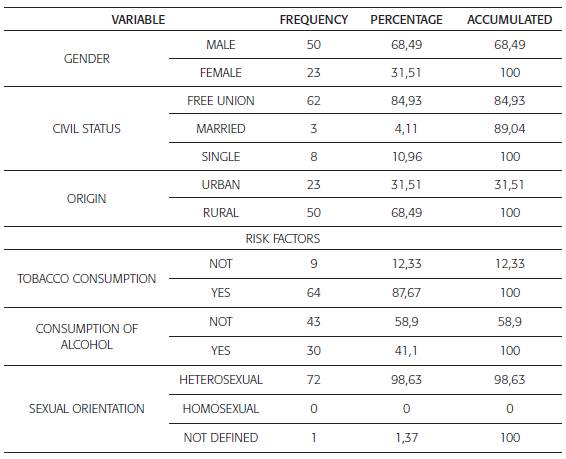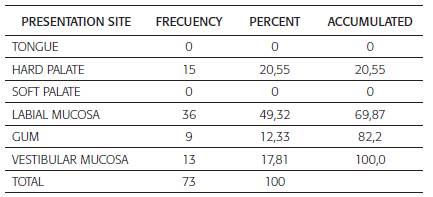INTRODUCTION
In recent years, the diagnosis of exophytic or verrucous lesions of the oral cavity has become important because of its relation to the human papillomavirus and the consequent possibility of malignant transformation. Oral cancer is a malignant neoplasm of aggressive behavior, 90% are of the oral squamous cell carcinoma type. It may be preceded by preexisting lesions called potentially malignant mucosal disorders; it mainly affects people older than 40 years, although diagnoses are reported in patients between 30 and 40 years, with a greater presentation in men 1
In Colombia, it is the third leading cause of death and oral squamous cell carcinoma occupies the fifth place among all cancers, with a 2:1 man-woman relationship. Approximately 2,000 new cases show up annually, mostly diagnosed in patients older than 60 and rarely in the population under 40 years. It is commonly associated with risk factors such as smoking, genetic predisposition and alcohol consumption; however, there is a growing relationship between the occurrence of oral neoplasm and viral conditions caused by human papilloma-virus (HPV), especially subtypes considered to be at high risk, such as: 16, 18 2,3
HPV is 55 nm in diameter, a circular double-stranded DNA nucleus; it belongs to the papillomaviridae family and is capable of producing hyperplastic, papillomatous, and verrucous lesions in both skin and mucosa. This virus has been shown to play an important role in carcinogenesis. The role of high-risk oncogenic HPV is well described in cervical cancer, but not in oral cancer 4,5
Human papillomavirus plays an important role in the pathogenesis of squamous cell carcinoma of the oral cavity and especially of the oropharynx in patients in whom no risk factors associated with smoking and alcohol are recognized 6,7. Nearly 30% of tumors can be caused by human papillomavirus infection, mainly in the oropharynx 8. In 2013, oncogenic HPV DNAwas reported to be detected in approximately 26% of all squamous cell carcinomas of the mouth 9. In 2013, Boscolo et al reported that HPV serotype 16 accounts for approximately 50% of cervical carcinomas and more than 90% of HPV positive oropharyngeal carcinomas 10. It is important to perform a molecular diagnosis in patients with verrucous lesions in the mouth to identify high risk genotypes of the virus and to implement a suitable preventive treatment, avoiding its transformation and progression to oral cancer 11.
The National Cancer Institute of Colombia, reported information about the oral cancer in 2010, which show that lip, oral cavity and pharyngeal cancer accounts for 2.3% (n: 144 cases) of all cases diagnosed that year whose mortality rate is 18.7% in men over 65 years of age and 10.7% in women 12.
Sexual behavior has been reported as a major risk factor associated with the presence of HPV in oral and buccopharyngeal squamous cell carcinomas, with sexual behavior and number of sexual partners being one of the main risk factors (RR 3.1, 95% CI, 1.5-6.5) as well as the practice of orogenital relations (RR 3.4 95% CI 1.3-8.8) 13,14.
Several studies have reported the presence of oral cavity and oropharyngeal tumors associated with HPV in young patients (40 to 60 years of age) compared to patients with HPV negative, who on average are 5 years older 15-17. Regarding the man: woman relationship, some studies report that there is a slight predominance in men (3:1) compared to women in tumors of upper airway pathways. 18,19
The methods used for the diagnosis of HPV infection are mainly based on the detection of viral DNAand have been grouped in trials as following: high sensitivity (PCR, 37.1%), moderate sensitivity (Southernblot, 25.2%) and low sensitivity (In situ hybridization or immunohistochemistry, 16.9%). 20,21
The objective of the present study was to identify high-risk serotypes of human papilloma virus (vph) in patients with verrucous lesions of the oral cavity.
METHODS
Study design: The researchers conducted an observational, descriptive, prospective, cross-sectional study to determine the prevalence of human papillomavirus serotypes in 73 patients with verrucous lesions in the oral cavity in a population of a hospital in the city of Cartagena in the period of July 2014 to July 2015. The researchers defined for convenience to study all patients who had lesions suggestive of HPV during the mentioned period. For the development of the project, information was obtained from primary sources such as observation, the epidemiological record and the real time PCR result. From secondary sources such as the results of the biopsy (histopathology) and bibliographic sources that allowed the contextualization and discussion of the same. All patients, consciously and in full freedom decided to participate in the research signing the informed consent. From that moment the subject was programmed for the accomplishment of the clinical history and later for the taking of the sample that will be used for the anatomopathological study and for the PCR. For the anatomopathological, study the samples were fixed in 5% formalin and processed by means of the classic paraffin inclusion technique; They were then stained with hematoxylin-eosin and the lamina was observed under a light field optical microscope, with 10x and 40x magnification to observe the histological changes and degree of cell involvement due to infection by this virus. Histopathological results were reported as changes compatible with HPV infection or HPV negative. Positive samples with changes compatible with HPV infection were stored for molecular study processing following thuis protocol: 1. Sample collection and management: excisional biopsy with free borders stored and transported in Abbott Cervi-Collet Specimen Collection Kit tubes, catalog: 4N73. Each 2.5ml tube contains Guanidin Tiocinate in Tris buffer which inhibits bacterial growth and preserves DNA. 2. Preservation of the sample: the samples were stored in the molecular biology laboratory at -20 °C until the moment of their use. 3. DNA extraction was performed in an automated way in the molecular biology laboratory of IPS Dinámica in Medellín, using the automated equipment Abbott m2000 for Sample Preparation instrument, catalog No. 09K14-090, together with the set of reagents Abbott Sample Preparation System DNA, Catalog No. 06K12-24 employing the principle of microparticles and temperature gradients giving a DNA recovery efficiency greater than 98% from liquid media. 4. Real-time multiplex PCR: performed at the molecular biology laboratory of IPS Dinámica in Medellín where the presence of high-risk HPV DNA was evaluated using the Abbott Real Time High Risk HPV reagent kit catalog No. 2N09-90 With IVD certificate (in vitro diagnostic devices) and sanitary registration INVIMA: 2009RD-0001267. Using the Abbott m2000 6-channel real-time thermal cycler Catalog No: 09K15-090. Multiplex real-time PCR containing 5 primers was performed to amplify the target DNA of HPV. Three forward primers and two reverse primers directed to the conserved L1 region of HPV are employed. This PCR design allows the detection of 14 high-risk HPV genotypes in a single reaction, achieving individual identification of genotypes 16 and 18 and group identification of 12 other high-risk genotypes (31, 33, 35, 39, 45, 51, 52, 56, 58, 59, 66 and 68). As internal control of PCR amplification and a correct DNA extraction, the gene of human beta-globin in each of the samples is identified and amplified, plus two analytical controls: one positive and one negative. Legal and bioethical considerations: this study was supported taking into account the legal regulations, according to Article 11 of Resolution 8430 of 1993 of the Ministry of Health and the Helsinki Declaration of 1975, amended in 1983. Descriptive statistics were carried out by reporting frequencies, ratios. For quantitative variables, mean and standard deviation were reported prior to analysis of normal distribution of data using the Shapiro-Wilks test with a Stata software.
RESULTS
In the 73 patients with verrucous lesions suggestive of human papillomavirus infection, the prevalence of HPV was 9.59% (n: 7). To these patients with a positive result for HPV by histopathology, real-time PCR was performed in search of high-risk HPV serotypes, more specific genotyping of 16 and 18, finding that 100% of the cases studied were negative for HPV serotypes of high risk (graph 1). The mean age of the population studied was 62.8 years (SD ± 17.74), a minimum age of 26 years and a maximum age of 91 years. It was evidenced that the greatest number of patients are at ages equal or superior to 60 (graph 2).

Figure 1 Distribution of the population according to the results of anatomopathological analysis and real-time PCR for the search of high-risk HPV serotypes

Figure 2 Age intervals of patients attending consultation of maxillofacial surgery at the hospital of Cartagena during the period 2014-2015
As for the sociodemographic variables a predominance of male, free union and rural origin were observed. All of them stated that they were heterosexual, and the majority said they had a habit of smoking; these results can be seen in table 1. It was also possible to observe a higher prevalence of lesions in the labial mucosa, while no lesions were found on the tongue (table 2). The greatest numbers of lesions were located in the labial mucosa, followed by lesions on the hard palate (table 2). Of the 7 biopsy specimens positive for HPV by pathology, 4 (57.1%) presented lesions on buccal mucosa and the other 3 (42.9%) on the labial mucosa.
Table 1 Frequency table of socio-demographic variables and risk factors of patients attending consultation with maxillofacial surgery at the Hospital of Cartagena during the period 2014-2015

DISCUSSION
HPV is the causative agent of cervix cancer and appears to be involved in the etiology of cancer of the oral cavity, which indicates the execution of studies in non-cancerous lesions, but there is little evidence of molecular tests performed on non-cancerous lesions in which its etiologic factor is the human papillomavirus, and evidence is growing that indicates that in squamous cell carcinoma genotypes of high-risk of this virus are detected, which suggests that lesions that are not cancerous and which are caused by HPV can become cancerous lesions.
The present study reports that the population with verrucous lesions suggestive of HPV infection is very heterogeneous, being present in both men and women. The results of the present study showed that those with HPV positive for biopsy were mostly male. Although in the total population smoking was high (87.67%), in those patients with HPV positive for pathology, this variable was not very representative, since only two (28.6%) had this habit. These results contrast with those reported by Medina et al., which had a greater presence in the female sex and in the smoking habit (60%), assuring that smoking is an important cofactor for infection by this virus. 22
In 2008, Llamas-Martínez S et al. 23 published a study in which the HPV genome was detected in 23.3% of patients in a control group with healthy mucosa in 45.7% of patients with oral leukoplakia and in 39.4% of oral squamous cell carcinomas. In this study, the researchers found a relationship between serotypes 6, 11, 16 and 31, the first two considered as low risk, and the clinicopathological findings found. These reports demonstrate how HPV genotypes can be detected in healthy oral mucosa or benign lesions. Data explaining the results obtained in the present investigation, where the low prevalence of HPV in vegetative lesions (9.59%) specific for serotypes 16-18 does not allow establishing relationships between clinical findings, histopathological findings and the presence of HPV. The aforementioned authors report a prevalence of HPV in healthy oral mucosa of 23.3%.
Estrada P et al., in 2013 published a descriptive and cross-sectional study of 85 patients with oral lichen planus associated with human papillomavirus. These patients were biopsied to evaluate the main histopathological findings and their relationship with clinical and demographic characteristics. The most relevant results of this study show that conditions predominated in both sexes; the age group of 20 to 29 years was the most affected, whereas the most susceptible anatomical site in the installation of the infection was the buccal mucosa, with a 63.6%, followed in sequence by dorsum and lateral tongue border, with 16.4%. These data differ from our reports, as regards to the sex of presentation of the affections, our study reports preference for the male sex (68.49%), the most frequent location in our study was the hard palate followed by the buccal mucosa with a 17.81%, unlike the Estrada P report, in which the inner cheek was highly affected by lichen planus associated with HPV. In terms of age, differences were also observed, since in the present report the mean age was 62.8 years, Estrada et al. reported a higher incidence at earlier ages (20-29 years). 24
González M et al., in 2014 published a literature review article to determine how HPV infection affects the prognosis of oropharynx geal cancer, the authors report that at least 30% of the cancers in this region are associated with HPV, they confirm that this relationship between malignant oropharyngeal neoplasia and the presence of HPV DNA has increased from 1988 to 2004, by 225% (95% CI: 208% and 242%) and increased from 0.8 cases per 100,000 to 2.6 cases per 100,000, while the ratio of patients with HPV negative oropharyngeal cancer has decreased by 50%, from 2 cases per 100,000 to 1 case per 100,000. The authors report in their literature review that neoplastic pathology associated with positive HPV is more commonly present in men, non-smokers and non-users of alcohol in which the habit of oral sex is a common denominator. The most common oropharyngeal condition that precedes cancer is leukoplakia and the area most prone to disease progression is the tonsils. In the report by González et al., there are data similar to those of our investigation, in what has to do with the most common sex of appearance of HPV-associated lesions, in our study, 68.49% of the population were men. Contrary to the considerations presented by González et al. regarding the cofactor associated with HPV positive patients, in our study the evaluated population, in 87.67% were cigarette consumers and 58.9% alcohol consumers. Our research does not explore whether patients have the habit of oral sex.















